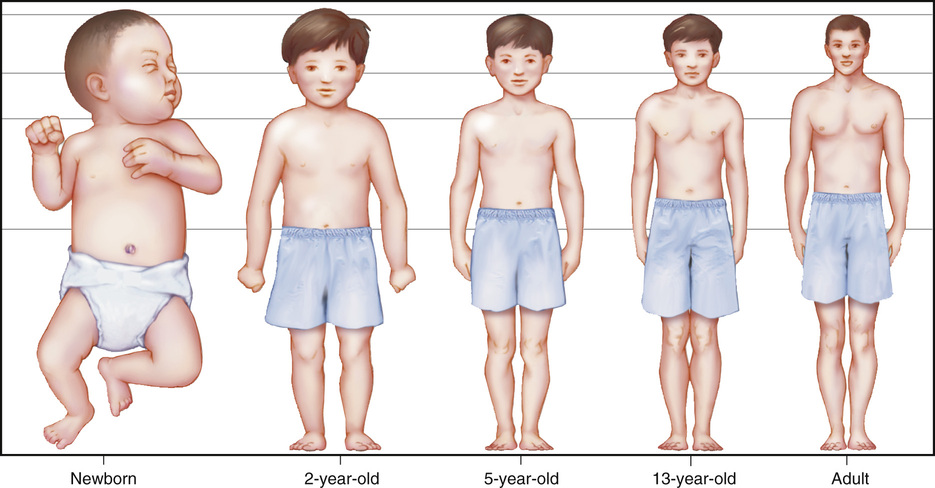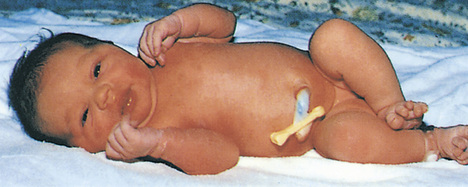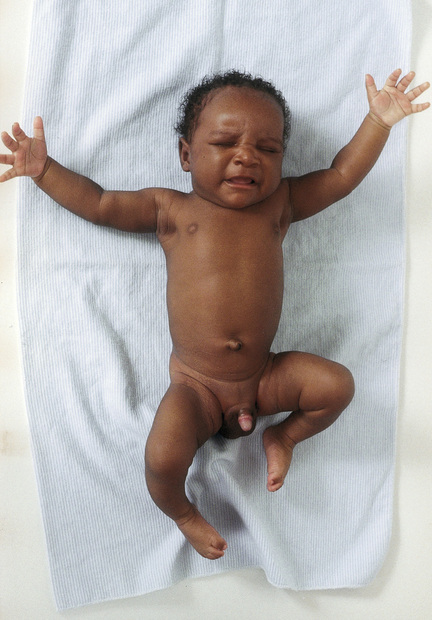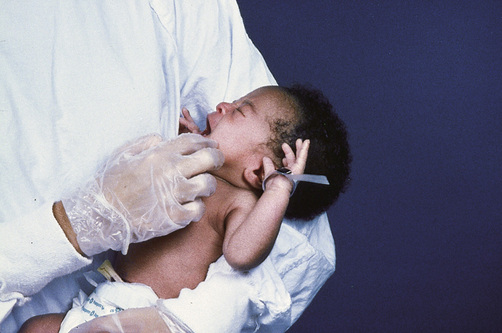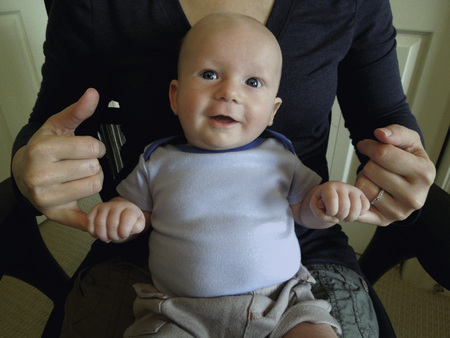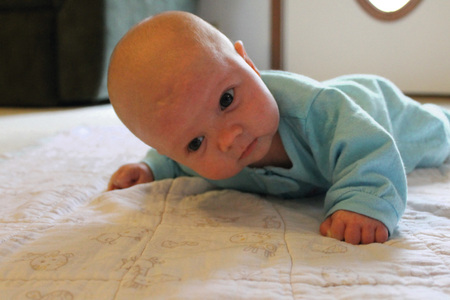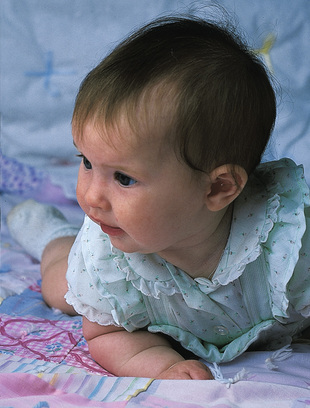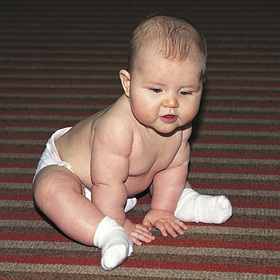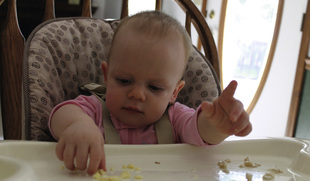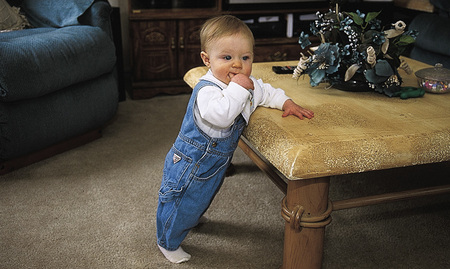Growth and Development
Objectives
• Define the key terms and key abbreviations in this chapter.
• Explain the principles of growth and development.
• Identify the stages of growth and development.
• Identify the developmental tasks for each age-group.
• Describe the normal growth and development for each age-group.
• Explain how to promote PRIDE in the person, the family, and yourself.
Key Terms
Growth is the physical changes that are measured and that occur in a steady and orderly manner. Growth is measured in weight, height, and changes in appearance and body functions (Fig. 11-1). Development relates to changes in mental, emotional, and social function. A person behaves and thinks in certain ways in each stage of development. For example, babies depend on adults for basic needs. Adults can meet most of their basic needs without help.
This chapter presents the basic stages of growth and development that occur in normal, healthy persons from birth until death. The stages overlap. It is hard to see the start and end of each stage. Also, the rate of growth and development varies with each person.
Growth and development theories usually involve the 2-parent family. Single-parent households are common. Sometimes relatives care for children. In this chapter, primary caregiver is used in place of mother, father, or parent. The primary caregiver is the person mainly responsible for providing or assisting with the child’s basic needs. A mother, father, grandparent, sister, brother, aunt, uncle, or court-appointed guardian may have this role. Parent and parents are used in this chapter. However, another primary caregiver may have the parent role.
Growth and development stages vary among experts. The groups and content in this chapter are broad and general.
Principles
Growth and development is a process affecting the whole person. Although they differ, growth and development:
For example, an infant coos or babbles (development) when the physical structures for speech are strong enough (growth). Basic principles of growth and development are:
• The process starts at fertilization and continues until death.
• The process occurs in certain directions.
• From head to foot. Babies hold their heads up before sitting. They sit before standing.
• The process occurs in a sequence, order, and pattern. Certain skills are completed during each stage. A developmental task is a skill that must be completed during a stage of development. A stage cannot be skipped. Each stage is the basis for the next stage. See Box 11-1, p. 128.
• Each stage has its own characteristics and developmental tasks.
Infancy (Birth to 1 Year)
Infancy is the first year of life. Growth and development are rapid during this time. During this stage infants:
• Begin to talk and communicate with others.
• Begin to have emotional relationships with parents, brothers, and sisters.
The Newborn (Birth to 1 Month)
The neonatal period of infancy is from birth to 1 month. A baby is called a neonate or newborn at this time. (Neo means new; natal and nate mean born.) The average newborn weighs 6 to 9 pounds. Birth weight doubles by 5 to 6 months of age. Birth weight triples by 1 year of age. The average 1-year-old weighs  pounds.
pounds.
The average newborn is about 20 inches long. Length increases in spurts. At 6 months, the average length is  inches. At 1 year the infant is about 29 inches.
inches. At 1 year the infant is about 29 inches.
The newborn’s head is larger than the chest. The trunk is long. The abdomen is large, round, and soft. The newborn has fat, pudgy cheeks, a flat nose, and a receding chin (Fig. 11-2, p. 128). At 1 year, the chest is larger than the head.
The skin is smooth. Light-skinned babies are reddish at birth but turn pink a few days later. Dark-skinned newborns may appear pinkish to yellowish brown. The skin turns to its natural color in a few days. Eyes are dark gray or deep blue in light-skinned babies. Dark-skinned babies have brown eyes.
The newborn’s central nervous system (CNS) is not well-developed. Movements lack purpose and are uncoordinated. Newborns can see from about 8 to 12 inches and can follow large objects. They like faces and bright colors. Newborns hear well. Loud sounds startle them. Soft sounds soothe them. They know the mother’s voice. They react to touch and pain. They can taste and smell.
Newborns have certain reflexes (involuntary movements). These reflexes decline and then disappear as the CNS develops.
• Moro reflex (startle reflex)—occurs when the baby is startled by a loud noise, a sudden movement, or the head falling back. The arms are thrown apart. The legs extend and then flex. A brief cry is common. See Figure 11-3.
• Rooting reflex—occurs when the cheek is touched near the mouth (Fig. 11-4). The mouth opens and the head turns toward the touch. This reflex is needed for feeding. It guides the baby’s mouth to the nipple.
• Sucking reflex—occurs when the lips are touched.
• Palmar grasp reflex—occurs when the palm is stroked. The fingers close firmly around the object (Fig. 11-5).
• Step (dance) reflex—occurs when the baby is held upright and the feet touch a surface. The feet move up and down and in stepping motions (Fig. 11-6).
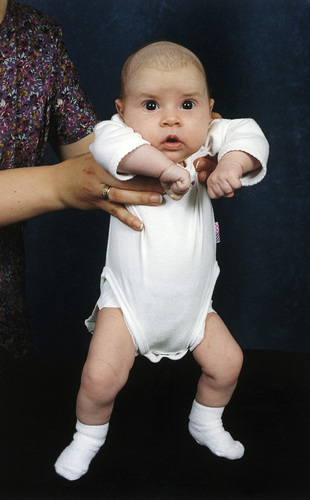
Specific, voluntary, and coordinated movements occur as the nervous and muscular systems develop. Newborns cannot hold their heads up. They turn their heads from side to side.
Newborns sleep 16 to 18 hours a day. They awaken when hungry and fall asleep after a feeding. Bottle-fed infants feed every  to 4 hours. Breast-fed infants are hungry more often—every 2 to 3 hours. The time between feedings lengthens as infants grow and develop. They also stay awake more and sleep less.
to 4 hours. Breast-fed infants are hungry more often—every 2 to 3 hours. The time between feedings lengthens as infants grow and develop. They also stay awake more and sleep less.
Infants (1 Month to 1 Year)
When on their stomachs, 1-month-old infants can lift their heads up briefly (Fig. 11-7). They also can turn their heads. They smile.
Two-month-old infants can hold their heads up when held straight. When on their stomachs, they can turn their heads from side to side. They need support to sit in an angled position. They smile in response to others (Fig. 11-8).
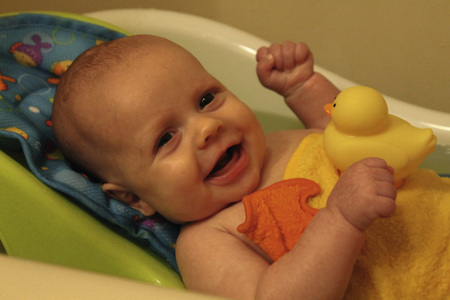
Infants 3 to 4 months of age can hold their heads up (Fig. 11-9). They reach for objects. The Moro, rooting, and grasp reflexes disappear.
By 4 to 5 months, infants can roll from front to back. They roll from back to front by 5 to 6 months. They also can sit by leaning forward on their hands (Fig. 11-10). Teething may begin with the bottom front teeth. They sleep all night. They can play “peek-a-boo.”
Solid foods are given at 4 to 6 months. Rice cereal mixed with breast-milk or formula is given first with an infant spoon. Fruits, vegetables, and meats are introduced slowly. These foods are pureed and thin at first. Thicker and chunkier foods are given as more teeth erupt and chewing and swallowing skills increase.
At 6 months, infants can bear weight when pulled to a standing position. They sit with support and move around by rolling. Some start to drink from a cup. They smile at themselves in a mirror. They respond to their names.
Crawling may start at 7 months. Infants can stand while holding on for support. They make sounds in response to caregivers.
At 8 months, infants can sit for long periods. They can change from lying to sitting and from sitting to lying positions. The pincer grasp develops—holding small objects with the thumb and index finger (Fig. 11-11). Infants can pick up small finger foods. They drink from a cup with handles.
When holding on to something, 9-month-olds can pull up into a standing position. They can hold a bottle, play “pat-a-cake,” and drink from a cup or glass. They understand their names and “no.” They point and use gestures to communicate.
At 10 months, infants can stand alone. They may walk with help or while holding on to something (Fig. 11-12). They also may crawl up stairs. At 11 months, they may walk alone and use push toys.
